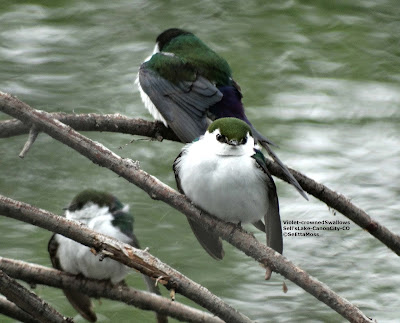Black-chinned Hummingbird that performed several Display Dives
Yesterday I watched a male Black-chinned Hummingbird performing several Display Dives that Birds of North America online (fee site) says, "...during breeding season Dive Display assumed to be a component of courtship." Right after the dives it flew off into the vegetation. While I only saw the hummer in flight I did see the purple band at the bottom of it's black chin clearly when the light hit it just the right way. I checked references and though this species is present in the Lower Rio Grande Valley during breeding season there are not a lot of records of that.
So I returned to McAllen Nature Center tonight at the same time as when I saw the Display Dives last night to see if I could refind this bird. And I did, it was only a short distance from where I observed it doing dives last night. Unfortunately it perched high in a snag and with lateness of day (7 pm) the photos did not come out as well as I would like. I did go get Jaxon Rickel, the new naturalist, and he was able to see this bird as it returned two more times to this same snag. He and others there can watch for other signs of breeding.
This bird has an unusual amount of dark feathers on it's underparts for this species but has established field marks for Black-chinned: head looks black, tail projects slightly beyond wingtips, and purple band on lower throat (observed only).
Below shows the location of the hummer with me shooting photos at a high angle. SeEtta
So I returned to McAllen Nature Center tonight at the same time as when I saw the Display Dives last night to see if I could refind this bird. And I did, it was only a short distance from where I observed it doing dives last night. Unfortunately it perched high in a snag and with lateness of day (7 pm) the photos did not come out as well as I would like. I did go get Jaxon Rickel, the new naturalist, and he was able to see this bird as it returned two more times to this same snag. He and others there can watch for other signs of breeding.
This bird has an unusual amount of dark feathers on it's underparts for this species but has established field marks for Black-chinned: head looks black, tail projects slightly beyond wingtips, and purple band on lower throat (observed only).
Below shows the location of the hummer with me shooting photos at a high angle. SeEtta







Comments